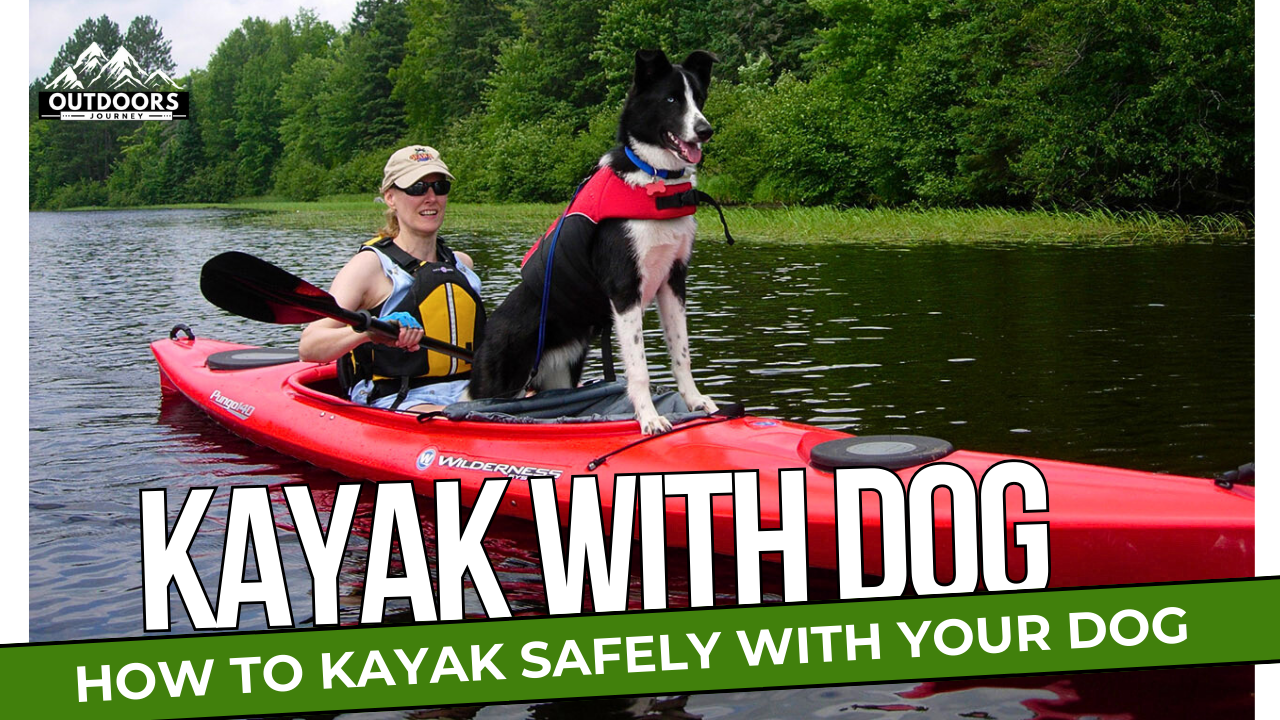Imagine the sun warming your face as you glide over the tranquil waters, your faithful companion by your side, tongue flapping in the breeze. Sharing the adventure of kayaking with your dog brings joy beyond words. But, not every dog loves the water. In fact, many may be afraid or dislike it, making it a challenge for you as their owner.
About 50% of dogs need time to get used to the noise and movements of kayaks. It’s important to introduce them gently and patiently to this new world. Safety is key—making sure your furry friend has a proper dog life jacket is crucial. In fact, it could be a lifesaver for some.
Many dog owners, around 85%, bring a first-aid kit along. Over 70% also use a leash during their kayaking adventures. You’re not just navigating the waters; you’re creating memories with your dog that will last forever. So, let’s get ready and learn how to make kayaking with your dog safe and fun!
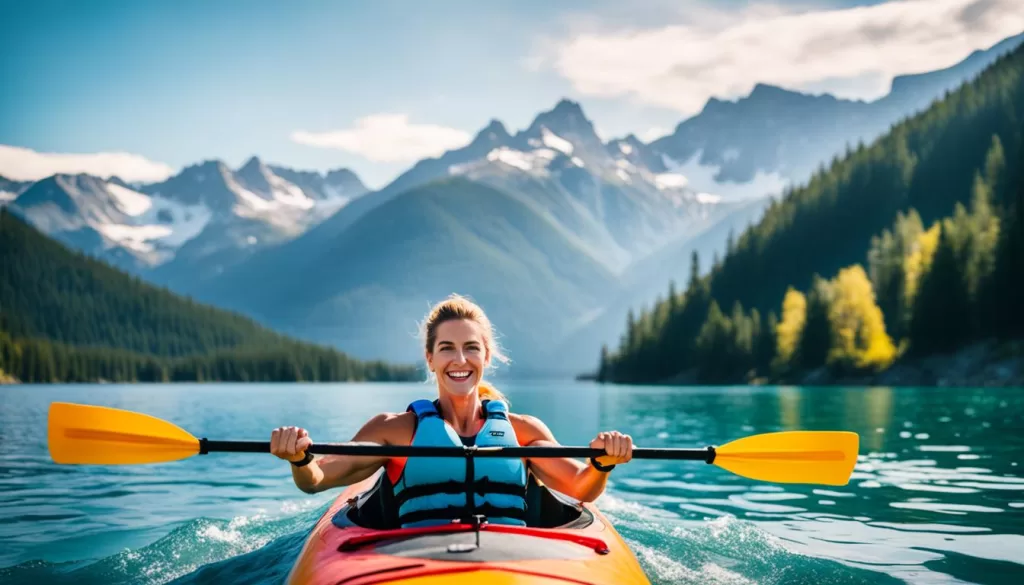
Key Takeaways
- Many dogs may initially be afraid of the water or dislike kayaking.
- Introduce your dog to kayaks slowly for a comfortable experience.
- A dog life jacket is essential for their safety on the water.
- Having a first-aid kit can be critical during outdoor activities.
- A leash helps maintain control of your dog near the water.
- Keep your dog hydrated with fresh water and treats while kayaking.
- 1 Introduction to Kayaking with Your Dog
- 2 Choosing the Right Kayak for Your Dog
- 3 Preparing Your Dog for the Kayaking Experience
- 4 Essential Safety Gear for You and Your Dog
- 5 How to Train Your Dog to Kayak
- 6 Taking Your Dog’s Maiden Voyage
- 7 Common Challenges When Kayaking with Dogs
- 8 Handling Your Dog During the Kayaking Trip
- 9 Health and Hydration for Your Dog
- 10 Navigating Different Water Conditions
- 11 Enjoying Your Time on the Water
- 12 Post-Kayaking Care for Your Dog
- 13 Final Thoughts on Kayaking with Your Dog
- 14 FAQ
- 15 Source Links
Introduction to Kayaking with Your Dog
Kayaking is a favorite activity for outdoor lovers, especially those with dogs. It’s a great way to spend time with your pet while enjoying beautiful lakes and rivers. This activity turns a simple outing into a special bonding moment.
Not every dog is ready for kayaking. It’s important to check if your dog likes water and listens to commands before you go. If your dog is scared of water or can’t follow commands, they might not like it. Training your dog and getting them used to water can make things easier.
When kayaking with your dog, safety comes first. Make sure your dog wears a life jacket, even if they can swim well. This keeps them safe in the water. Choose a kayak that suits the type of water you’ll be on, like calm lakes or rough rivers.
Having the right gear makes kayaking better. Bring towels, dry bags, and snacks to keep you and your dog ready for fun. Being patient and planning ahead makes your time on the water enjoyable.
Choosing the Right Kayak for Your Dog
Choosing a kayak for your dog means thinking about safety and comfort. The type of kayak you pick can greatly affect your experience, especially with a furry friend by your side. This guide will help you decide between sit-on-top and sit-in kayaks. It will also focus on finding a stable kayak that makes your time on the water enjoyable for both you and your dog.
Types of Kayaks: Sit-On-Top vs. Sit-In
When picking a kayak, it’s important to know the difference between sit-on-top kayaks and sit-in kayaks. Sit-on-top kayaks are great for stability, perfect for big dogs and new paddlers. They have an open design, giving your pet plenty of room to move. Sit-in kayaks keep you dry from wind and water but might not have enough space for bigger pets.
Best Kayaks for Dogs: Stability and Size
Looking for the right kayak for you and your dog? Check out these popular models:
| Kayak Model | Type | Weight Capacity | Notes |
|---|---|---|---|
| The Ocean Kayak Malibu Two Tandem | Sit-On-Top | 362 lbs | Stable and spacious for two paddlers and a dog. |
| The Intex Challenger Kayak | Inflatable | 325 lbs | Lightweight and Coast Guard approved. |
| The AdvancedFrame Convertible Tandem Inflatable Kayak | Inflatable | 550 lbs | Puncture-resistant, suitable for larger dogs. |
| The Sea Eagle 330 Deluxe | Inflatable | 500 lbs | Includes pump and paddles, great for beginners. |
| The Lifetime Triton Angler 100 | Fishing | 275 lbs | Designed for comfort and stability. |
| The Intex Explorer K2 | Inflatable | 400 lbs | Lightweight and offers a spacious layout. |
When choosing a kayak for size, make sure it can hold both you and your dog. Go for wider, stable models. Options like fishing kayaks or tandem inflatables are good for pets because they offer extra support. Getting the right kayak means you and your furry friend can have a great time on the water.

Preparing Your Dog for the Kayaking Experience
Getting your dog ready for kayaking means doing some important prep and training. Start with basic commands to set the stage for a good time. Use positive reinforcement to keep things calm and easy for your dog. Training your dog with simple commands like “sit,” “stay,” and “come” will help them behave well on the water.
Basic Training: Teaching Commands and Cues
Before you go kayaking, teach your dog some basic commands. This builds trust and understanding between you. Here are some tips:
- Use positive reinforcement to reward your dog when they do what you ask.
- Practice commands in different places to help your dog focus, even with distractions.
- Keep practicing basic commands often so your dog remembers them.
Good training makes your dog feel safe in new situations, like in a kayak. Regular practice helps them get more confident when the kayak moves on the water.
Building Confidence with Water and Motion
It’s important to slowly introduce your dog to water before kayaking. Here’s how to do it:
- Start with short trips to shallow water so your dog gets used to being near the water.
- Use stable surfaces, like a platform or dock, to make them feel comfortable with movement.
- Encourage your dog to try unsteady surfaces to build their confidence.
Training and playing can make your dog like the kayak. Let them get to know the kayak on land before you go on the water. A happy dog makes the whole experience better for both of you.
| Training Aspect | Detail |
|---|---|
| Basic Commands | Teach commands like “sit,” “stay,” “come.” |
| Positive Reinforcement | Use treats or praise to encourage desired behavior. |
| Water Acclimatization | Start with shallow water before progressing to kayaking. |
| Motion Simulation | Practice on stable surfaces to build confidence. |
Essential Safety Gear for You and Your Dog
Keeping you and your dog safe while kayaking is crucial. Having the right safety gear can greatly reduce risks and make your time on the water better. A dog life vest is a must-have for every dog owner. It keeps your furry friend afloat and helps them swim better in rough waters.
Importance of Life Jackets for Dogs
The American Canoeing Association says 85% of canoeists who drowned didn’t wear life jackets. This shows how important life jackets are for both humans and dogs. When picking a life vest for your dog, choose one that fits well and lets them swim easily. A good life jacket makes your dog safer and more confident in the water.
Other Safety Equipment to Consider
There are more safety items you should have for kayaking. Keeping your dog hydrated is key, so bring a collapsible water bowl and fresh water. Also, a dog first aid kit is a must for emergencies. Make sure it has gauze, non-stick tape, and waterproof booties.
- Collapsible water bowl
- Fresh drinking water
- Dog first aid kit
- Water-friendly dog toys
- Poop bags and towels
Don’t forget sunscreen and safety lights to protect your dog from the sun. Teaching your dog to follow commands while kayaking also boosts safety. With this gear, you and your dog can have a great time on the water, safely.
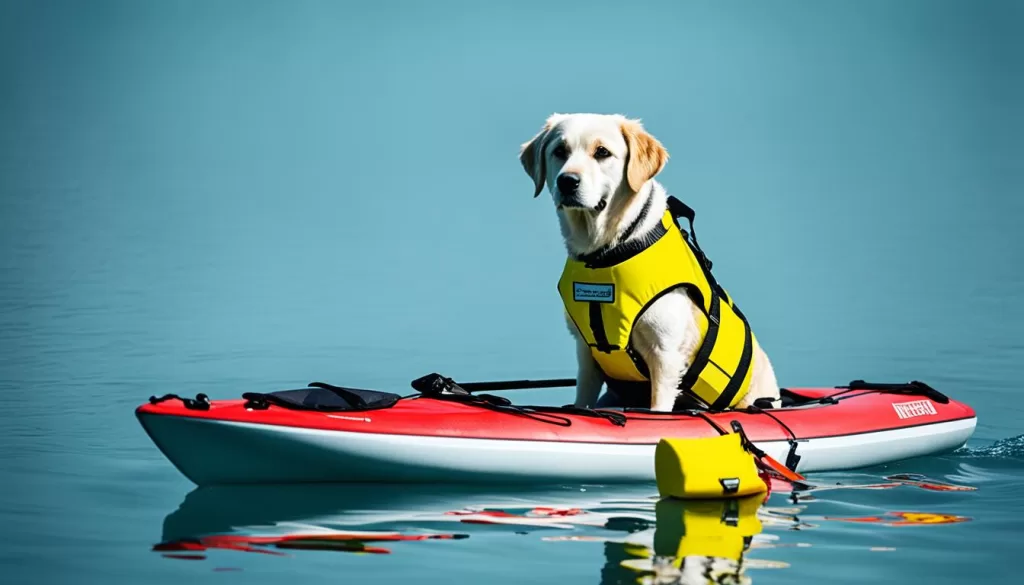
How to Train Your Dog to Kayak
Kayak training with your dog is fun and needs patience and consistency. Start training on land before putting your dog in the kayak. Let them get used to the kayak by exploring it while it’s still on the ground. Reward them for showing interest, stepping in, or sitting near it. This positive approach helps them connect the kayak with good things.
Use yoga mats and marine traction tape on the kayak for better stability and grip. This makes it easier for your dog to get in and out safely. As they face distractions like geese or other boats, teach them to stay calm. Training in a controlled setting helps them learn self-control, which is key for a peaceful time on the water.
Not every dog is quick to swim. For example, Lola might need extra help because she’s not keen on water. Young or energetic dogs might tip the kayak if not watched closely. So, train in shallow water near the shore for safety.
Start with recreational kayaks to make the experience easier for your dog. Make sure they wear a life jacket that fits well. Introduce them to the jacket before the water to help them get used to it. Keep harnesses and leashes ready for extra control if needed. Make sure your dog goes to the bathroom before getting in the kayak to make the trip stress-free. Never tie your dog to the kayak to keep them safe.
Teaching your dog off-leash commands is important for emergencies. With patience and consistent training, your dog will love kayaking with you.
Taking Your Dog’s Maiden Voyage
The moment has arrived for your dog to embark on their maiden voyage in the kayak! Choose calm waters for a gentle start. This makes it easier for your furry friend to adjust during their first kayaking experience.
Before you get on the water, follow these essential guidelines:
- Choose the Right Conditions: Opt for lakes or ponds on peaceful days. This choice minimizes unexpected waves and disturbances, providing a tranquil atmosphere.
- Use a Life Jacket: No matter how well your dog can swim, a life jacket is a must for safety. Select one designed with handles—brands like Alcott and Ruffwear make great options.
- Practice Boarding and Exiting: Teach your dog to enter and exit the kayak calmly. Gradually familiarize them with the kayak while still on land.
- Reinforce Commands: Ensure your dog responds to basic commands like “sit” and “stay.” This practice ensures they maintain composure throughout the journey.
Start your dog’s first kayaking experience in shallow water with supervision. Stay close so they feel secure taking the first steps into their new adventure.
To enhance your time on the water, keep fresh water and a travel bowl handy. Some dogs may find pond or lake environments less palatable, so it’s crucial to stay hydrated.
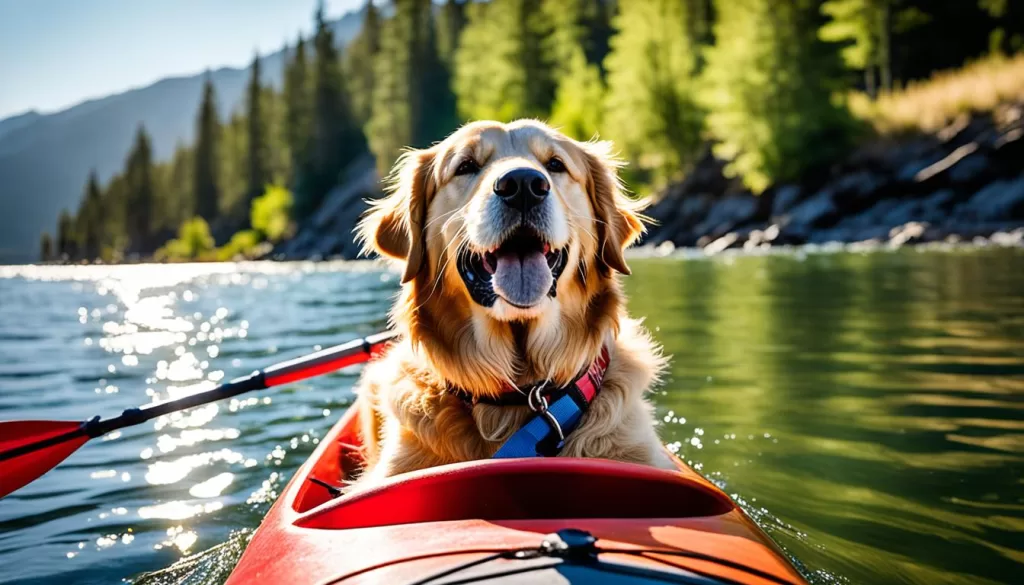
This structured approach to your dog’s first excursion sets a positive tone for ongoing kayaking adventures together. As your dog gains confidence over time, each trip will become a cherished memory.
| Key Considerations | Details |
|---|---|
| Water Conditions | Calm lakes or ponds with little to no current. |
| Life Jacket | Handle-equipped jackets are essential for safety. |
| Dog Commands | Teach “sit” and “stay” for better control. |
| First Aid Kit | Always carry an emergency kit for peace of mind. |
Common Challenges When Kayaking with Dogs
Kayaking with dogs can be challenging. You’ll need to watch out for things like wildlife and other boats. It’s important to stay calm and focused to keep your dog safe. Watch how your dog acts around sudden sounds or movements to know how to act on your trips.
Dogs often need to stop and drink water or go to the bathroom. It’s key to plan for these breaks. Giving your dog chances to stretch and drink will make them happier and more comfortable.
Training your dog is crucial to help them feel less anxious while kayaking. Teach them to stay in the kayak and listen to commands like “sit” or “stay.” Getting them used to the kayak on land will make it easier for them in the water. Training in quiet places helps them get ready for busier areas.
Work on making your dog comfortable around water before you go kayaking. Slowly introduce them to different places and situations to reduce their fear. With good training, you and your dog will have a better time kayaking together.
| Challenge | Possible Solutions |
|---|---|
| Dog distractions | Remaining calm, redirecting attention, and practicing commands. |
| Need for frequent stops | Plan breaks for hydration and stretching. |
| Dog anxiety | Gradual acclimation, positive reinforcement, and early exposure to training. |
Handling Your Dog During the Kayaking Trip
Your kayaking trip with your furry friend should be fun and safe. A good way to handle your dog is to find a spot in the kayak that keeps it balanced. A 60 lb dog can fit well between your legs, making the kayak stable and giving you better control.
Some people put their dogs in the kayak’s rear hatch on a bath mat to prevent slipping. Dogs feel secure in a special spot. Using a solo canoe can make paddling easier, adding to the adventure. If you choose a kayak, add carpet or rubber for your dog’s non-slip surface.
Introduce your dog to kayaking slowly. Start training them to wear a Personal Flotation Device (PFD) when they’re puppies. Ruffwear makes safe and flexible options. Always carry water for your dog to keep them hydrated.
Don’t open the rear hatch while paddling to avoid making the kayak unstable. A sea sock can help your dog stay dry if you tip over. Choose calm waters for the best kayaking experience with your dog.
Knowing how your dog acts is key to a good trip. Some dogs like water more than others. Teaching them commands like “ON,” “OFF,” and “LAY DOWN” helps them feel safe.
Here’s a checklist for your trip:
- High-quality dog PFD
- Fresh drinking water
- Ziplock of treats
- Comfortable dog sitting gear
- Water-friendly toys
- Bag for scooping poop
- Sun protection items
- Leash (not used in the kayak)

Spending time training and preparing makes the trip better for you and your dog. Learn dog CPR and first aid for emergencies. Aim to connect with your canoe partner and enjoy the water together.
Health and Hydration for Your Dog
When you take your dog kayaking, keeping them healthy and hydrated is key. A hydrated dog means they’ll have fun without getting tired or sick. Make sure to bring fresh water in a big enough container for them.
Before you start, check if your dog is ready for the activity. Safe exercises before kayaking can help them build up their strength and stamina. A calm, confident dog will listen better and enjoy the trip more.
Take breaks during your trip for your dog to drink water and rest. Direct sunlight can make dogs overheat, so make sure they have shade to cool off. Watch for any signs that they’re not doing well, so you can act fast and keep the trip safe and fun.
Use treats to encourage good behavior or calm your dog if they’re scared. Also, consider using dog sunscreen to protect their skin from the sun. With the right planning, including fresh water, you and your dog will have a great time together.
Navigating Different Water Conditions
Kayaking with your dog requires understanding various water conditions for a safe and fun trip. Paddling in salt water is different from calm lakes. Knowing the unique features of each can make your adventure better.
In salt water, you’ll face stronger currents and tides that can make it hard to stay stable. Always check the tides and weather before you go out. Look for calm spots in the water for a safer trip for you and your dog. Be careful with deeper waters, as they can be risky even for strong swimmers.
On the other hand, clean water in lakes and rivers is calmer. A calm lake is perfect for beginners, especially if your dog is new to kayaking. The water is usually calm, making it easier for your dog to feel safe in the kayak.
Always put safety first, no matter the water type. Make sure your dog wears a life jacket in new conditions. Keep fresh water on hand to stop your pet from drinking bad water, which can cause dehydration and health problems.
Start your kayaking trips short to help your dog get used to new conditions slowly. Begin in a calm lake or a safe spot before going into rougher waters. This way, you both can have a good time.
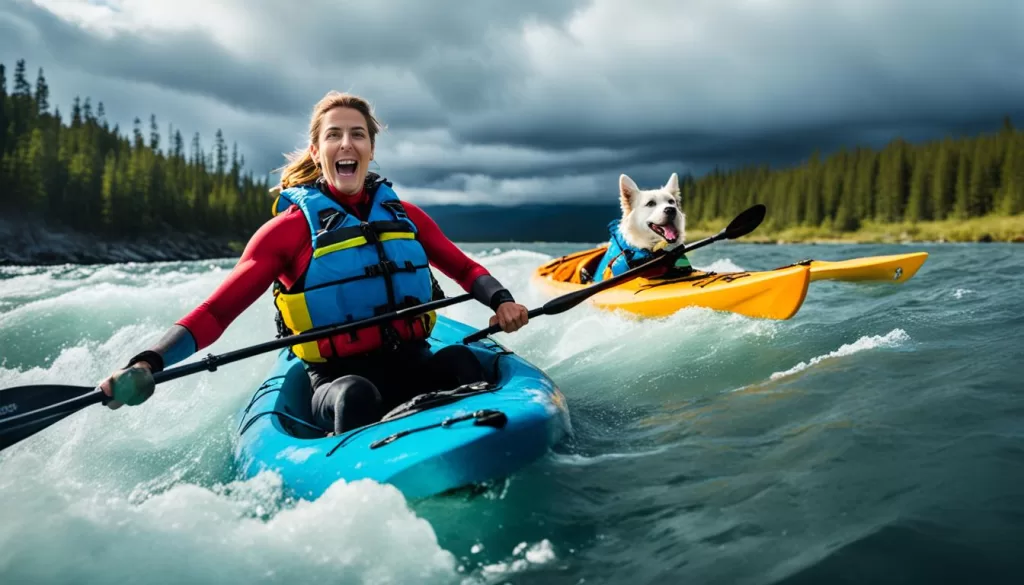
Enjoying Your Time on the Water
Spending time on the water with your dog is a great way to bond. Activities like kayaking help you grow closer while enjoying nature. Being out on the water with your furry friend creates moments you won’t forget and strengthens your bond.
As you move through calm waters, you’ll feel the joy of being in nature together. Exploring lakes or rivers makes you work as a team. It’s key to make sure your dog is comfortable in this new setting. Introduce them slowly to the kayak and water to keep them happy and calm.
There are many dog-friendly boats like kayaks and rafts to choose from. Many places let dogs come along, making it easy for fun outings. Always put a life jacket on your dog for safety. Kayaking with your dog is a great way to make memories that you both will love.
| Watercraft Type | Suitability for Dogs | Rental Availability |
|---|---|---|
| Kayaks | High | Often Available |
| Paddle Boards | Medium | Commonly Available |
| Inflatable Rafts | High | Often Available |
| Canoes | High | Widely Available |
| Rowboats | Medium | Sometimes Available |
| Small Ferry Boats | Variable | Limited Availability |
Watch for signs that your dog is not happy as you enjoy the water. Spending time with your dog in the water will make your bond stronger and create memories that last forever.
Post-Kayaking Care for Your Dog
After kayaking, make sure your dog feels safe and comfortable. Begin with a rinse in clean water to get rid of salt or dirt from their fur. This helps prevent skin problems and keeps their fur in good shape. Check for any signs of irritation or scratches during this bath, as part of a regular health check.
Make a cozy spot for your dog to relax after the outing. Offer fresh water and some treats to thank them for their bravery. This boosts their dog care. Give them a quiet place to rest, helping them recover from the day’s activities.
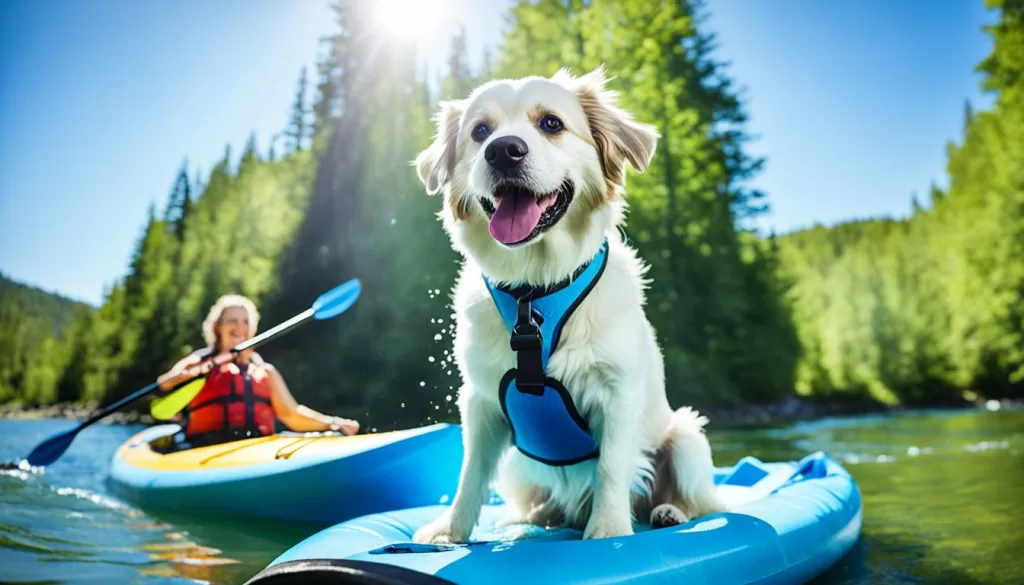
Watch for any odd behavior or if they seem less interested in usual activities. These signs might mean they need more rest or are feeling uncomfortable. Always check their health with regular vet visits, especially after kayaking, to keep an eye on their well-being.
With the right care and attention, your dog will be eager for more kayaking trips with you!
Final Thoughts on Kayaking with Your Dog
Kayaking with your dog can make your outdoor adventures unforgettable. With the right preparation and patience, you and your furry friend can have a great time. Every dog is unique, so consider their size, comfort, and water confidence before you start.
This activity strengthens your bond and lets you both enjoy nature. It’s important to remember that safety comes first. Make sure your dog wears a life vest and has a comfy spot in the kayak.
Be aware of wildlife and your dog’s training needs when picking where to kayak. This will help you make better choices and have a good time exploring.
Kayaking with your dog opens up a world of adventure. Whether you have a big or small dog, the joy of paddling is special. Get ready and enjoy the journey with your pet!
FAQ
What type of kayak is best for kayaking with my dog?
Should my dog wear a life jacket while kayaking?
How can I train my dog for kayaking?
What should I bring for my dog’s comfort during the kayaking trip?
How do I ensure my dog stays calm while paddling?
What should I do if my dog gets anxious on the water?
Can I kayak in both freshwater and saltwater with my dog?
What are some post-kayaking care tips for my dog?
Source Links
- How to Canoe or Kayak with Your Dog | Eukanuba – https://www.eukanuba.com/us/health-and-fitness/health-and-fitness-articles/how-to-canoe-or-kayak-with-your-dog
- Sea kayaking with my dog! – https://forums.paddling.com/t/sea-kayaking-with-my-dog/72198
- How I Go Kayaking with My Dog – Owe it to Spaghetti – https://www.oweittospaghetti.com/kayaking-with-my-dog/
- How to Kayak With a Dog I Kokopelli – https://kokopelli.com/blogs/things-to-know/paddle-pals-tips-for-kayaking-with-your-dog?srsltid=AfmBOopndTLwl5jy1bF-ddaKKiBuIY77ZaiX4Lep2uOkfljyiarqQnVa
- How to Safely Kayak with Your Dog – https://www.thewildest.com/dog-lifestyle/kayaking-with-dogs
- Kayaking With a Dog: Tips and 6 Dog-Friendly Kayaks to Consider – Vetstreet – https://www.vetstreet.com/gear/dog-gear/kayaking-with-a-dog
- Guide to Choosing a Kayak for Kayaking with Your Dog – https://dogpacking.com/guide-to-choosing-a-kayak-for-kayaking-with-your-dog/
- Kayaking With Your Dog: A Guide | BlackPaw Dog Training – https://blackpawdogtraining.com/kayaking-with-your-dog/
- Tips for Kayaking With a Dog – https://adventureandthegirl.com/2022/08/02/tips-for-kayaking-with-a-dog/
- kayaking with a dog – https://forums.paddling.com/t/kayaking-with-a-dog/62803
- CANINE CANOEING…our tips for successful dog paddling! – https://vermontpaddlepups.com/canoe-canoeing-our-tips-for-successful-dog-paddling/
- Water safety and boating with dogs – https://orbiloc.com/water-safety-and-boating-with-dogs/
- Kayaking with a dog – https://www.mountainbuzz.com/threads/kayaking-with-a-dog.28558/
- No title found – https://www.akc.org/expert-advice/health/how-to-kayak-with-your-dog/
- How to Train Your Dog to Ride in a Kayak – https://wagwalking.com/training/ride-in-a-kayak
- How to Kayak With a Dog I Kokopelli – https://kokopelli.com/blogs/things-to-know/paddle-pals-tips-for-kayaking-with-your-dog?srsltid=AfmBOoqN7mbOWkcRpiDyoUf4koUiyOlT8ObLP7wnNqaxfSahbkC0rAmy
- Reader’s report: Kayaking and paddleboarding with your dog – https://www.dogjaunt.com/2016/08/readers-report-kayaking-and-paddleboarding-with-your-dog/
- Your Dog and Your Inflatable Kayak – Portable Kayaks – https://www.portablekayaks.com/your-dog-and-your-inflatable-kayak/
- Dogs and Kayaers – what to do? – https://www.mountainbuzz.com/threads/dogs-and-kayaers-what-to-do.11791/
- Paddling With Your Pup – Simply Buckhead – https://simplybuckhead.com/paddling-with-your-pup/
- Kayaking with Your Dog – https://brooklynkayakcompany.com/blogs/our-blog-2/kayaking-with-your-dog?srsltid=AfmBOooHPQ6pYXThBhfrqcl2z06UnFH0m61blcljK72DYGPJYc31fbIC
- Kayaking with dogs – https://forums.paddling.com/t/kayaking-with-dogs/22841
- Kayaking with Your Dog – https://brooklynkayakcompany.com/blogs/our-blog-2/kayaking-with-your-dog?srsltid=AfmBOooLq7x19SyN3Eni5_EbbZJ1NVUFIXHXhDGJTTzBsjVRtx3JmPBJ
- How to Kayak With Your Dog Safely (And Have the Best Time Ever) – https://be.chewy.com/getting-your-dog-kayak-ready/
- 6 Tips for Kayaking With Your Dog – https://bestmarineandoutdoors.com/blogs/news/top-6-tips-for-kayaking-with-your-dog?srsltid=AfmBOookkYUogkBAz1grD5tj6HO5LtsEG4xi071yv2w8T2u_ru9JFUHs
- How to Canoe and Kayak with Your Dog – https://bendingbranches.com/blogs/resources/how-canoe-and-kayak-your-dog
- The Complete Guide to Kayaking and Canoeing with Dogs – https://backroadramblers.com/complete-guide-paddling-dogs/
- No title found – https://www.akc.org/expert-advice/travel/boating-kayaking-with-dogs/
- Kayaking with Dog? – https://forums.paddling.com/t/kayaking-with-dog/35345
- How to Safely Kayak with Your Dog | Kayaking Tips from Log Kayak Rack – https://www.logkayakrack.com/how-to-safely-kayak-with-your-dog/
- 6 Tips for Kayaking With Your Dog – https://bestmarineandoutdoors.com/blogs/news/top-6-tips-for-kayaking-with-your-dog?srsltid=AfmBOooCXORbWFhU5ihYPeKpN-qcvxNghDs41zKak58dj2wpjhkKPKTO
- How to Take Your Dog Canoeing & Kayaking: 10 Vet-Approved Tips for Safety – Dogster – https://www.dogster.com/lifestyle/how-to-take-your-dog-canoeing-and-kayaking
- Kayaking with a dog – https://www.germanshepherds.com/threads/kayaking-with-a-dog.748423/
- Kayaking with your dog – https://forum.chronofhorse.com/t/kayaking-with-your-dog/382343
- Doggy Paddling: Kayaking With Your Best Friend – https://paddlingmag.com/skills/doggy-paddling-kayaking-with-your-best-friend/
